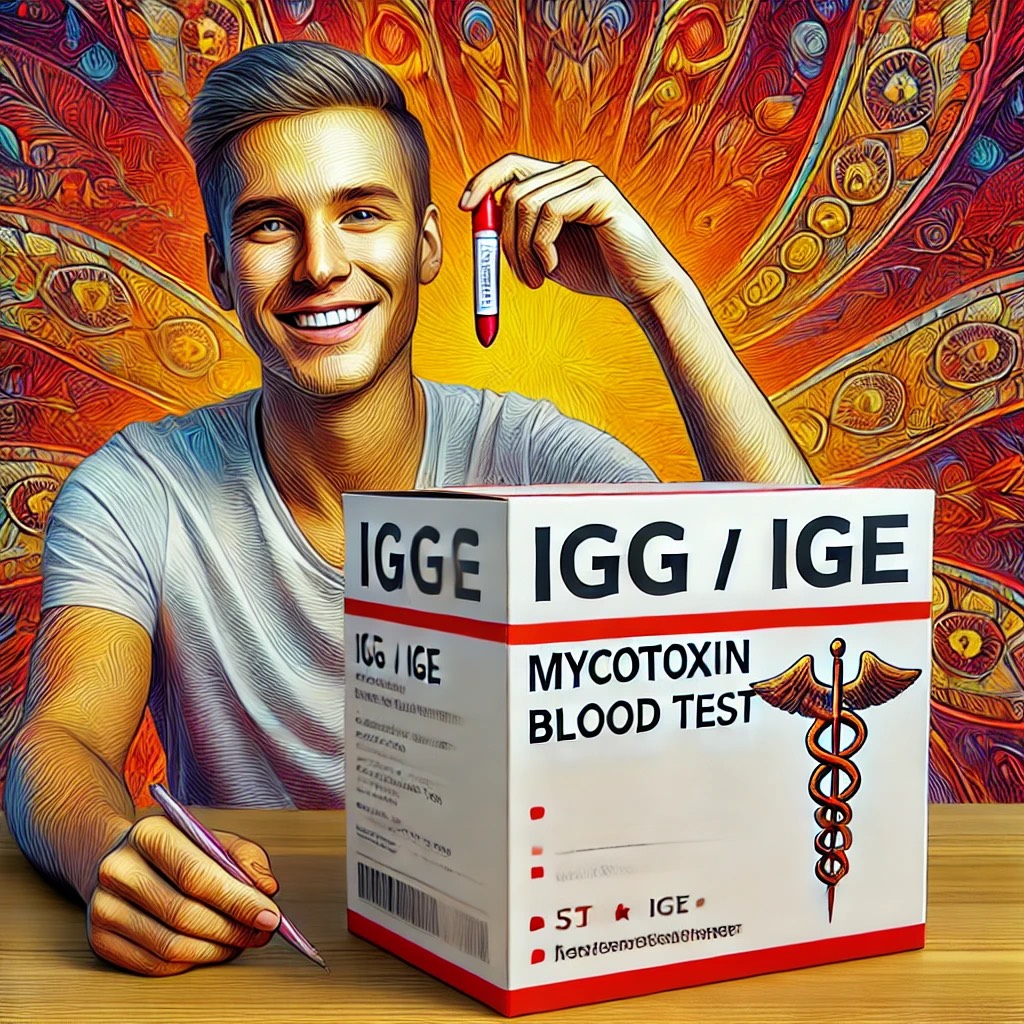IgG/IgE Mycotoxin Blood Test- Gold Standard of Mold Testing
 There are plenty of mold tests on the market that can give you a good idea of whether mycotoxins are making you sick. The problem is, none of these test your immune system’s reactivity to the mycotoxin itself. The fact is, the immune reactivity dictates the severity of symptoms. Someone could have 10 times the mycotoxin levels of another person and show fewer symptoms. This is why the IgG/IgE mycotoxin blood test is now the gold standard of mold illness testing. It measures your system’s immune reaction to the mycotoxins, not just how much there is inside you.
There are plenty of mold tests on the market that can give you a good idea of whether mycotoxins are making you sick. The problem is, none of these test your immune system’s reactivity to the mycotoxin itself. The fact is, the immune reactivity dictates the severity of symptoms. Someone could have 10 times the mycotoxin levels of another person and show fewer symptoms. This is why the IgG/IgE mycotoxin blood test is now the gold standard of mold illness testing. It measures your system’s immune reaction to the mycotoxins, not just how much there is inside you.
In this article, I will cover the current testing options for mycotoxin illness. Afterward, I will list several reasons why the IgG/IgE mycotoxin blood test is better than the rest. I will answer several questions so you understand this cutting-edge mold test. Let’s get started!
Current Mycotoxin Testing Options
Mycotoxin Urinalysis
The mycotoxin urinalysis measures the amount of various mold toxins in your blood. It can be helpful to identify if your body is saturated with mycotoxins. If you show up with high levels of mycotoxins and have lived in the same place for a while, it confirms that your home is contaminated with toxic mold. From there, you can at least have enough evidence to create a plan to eliminate exposure and remove the mycotoxins from the body.
ERMI Indoor Mold Test
The EPA designed the ERMI mold test to measure the spore count of 36 different toxic molds. It provides the spore count, reference ranges, and an overall moldiness score from -20 to + 20. It can measure active/dormant spores and mold strains instead of just species. This was the gold standard of indoor mold testing for over a decade. As long as the collection process is done properly, it will give you a snapshot of the moldiness in your home. The only problem is that it doesn’t measure the mycotoxins in the home or your level of immune sensitivity to them. This is why it is a helpful tool, but it can’t diagnose mold illness alone.
EMMA Mycotoxin Indoor Mold Test
The EMMA mold test measures 10 toxic molds and 16 mycotoxins. It is the most cutting-edge indoor mold test on the market. It uses liquid chromatography and mass spectrometry to identify fractions/fragments of spores rather than entire spores. This allows you to see even the smallest pieces of mold, which are the most dangerous because they penetrate the deepest.
Also, the EMMA measures the levels of mycotoxins in the home. This is critical because mycotoxins are the actual cause of the symptoms. You could have a home show up with relatively low spore count but high levels of mycotoxins. This is why the EMMA mold test stands out from the rest of the indoor tests. For a review of the ERMI/EMMA mold tests in further detail, click the link provided.
Why IgG/IgE Mycotoxin Test is the Best Option
Measurement of Immune Response
Identifies Acute and Chronic Exposure
High Sensitivity and Specificity
Insight into Systemic Effects
Great for Tracking Immune Progress
Broader Scope of Toxins Tested
Helpful for Symptom Correlations
Objective Data for Mold Sensitivities
Support for Insurance and Legal Claims
This test can be extremely helpful for supporting legal or insurance claims in situations where mold exposure impacts quality of life. The IgG/IgE mycotoxin blood test is direct evidence that an immune response is occurring. With these results, it can no longer be disputed that mycotoxins are negatively impacting someone’s immune system. Now, there is direct proof through the measurement of the IgG and IgE responses.
Frequently Asked Questions- Using IgG/IgE Mycotixin Blood Test
Is the IgG/IGE test the best diagnostic tool for mold illness?
The IgG/IgE mycotoxin blood test is the best tool for diagnosing mold illness. Not only does it show you your immune reaction to all of the different mycotoxins, but it also provides the severity of the reaction. In addition, it breaks it into IgG/IgE, which shows you if exposure has been long-term, acute, or both. Remember that the severity of your symptoms will depend on how strong your immune response is. This is the only known mold illness test to quantify that.
How much does the IgG/IgE mycotoxin blood test cost?
If you purchase it through MyMycolab.com, it costs $380. This is similar in cost to other mold tests, like the mycotoxin urinalysis. I know that can be expensive for most people, but trust me, it’s well worth it if you’re struggling with a chronic health issue.
Should I still test my house for mold using the IgG/IgE test?
If you wanted a complete picture of everything in your environment, you would combine the IgG/IgE mycotoxin blood test with the EMMA test. This would allow you to measure the mycotoxin levels in your home, the amount of fragmented spores, and your immune response to them. With all of this information, the diagnosis would be conclusive.
Is it helpful to get a mycotoxin urinalysis to detect mold illness?
The mycotoxin urinalysis is helpful in understanding the toxic burden the client is under. Unfortunately, the problem is that your level of symptoms will depend upon your immune system’s level of reactivity. By combining the IgG/IgE and urinalysis test, you can measure the amount of mycotoxins in your system and your immune response to them. This will help you quantify your progress from both angles as you recover from mold illness.
Is the IgG/IgE mycotoxin blood test worth investing the money in?
Absolutely! Trust me, if you don’t address the possibility of mycotoxins, you may miss the boat. For example, my daughter was extremely sick for several years because I didn’t follow through after I heard about mold illness. Once I believed in it and made all the necessary changes, she was symptom-free in 6 months. Without testing, I could have never identified that she had black mold toxins in her body. This allowed me to make the proper decisions to support her recovery.
Conclusion- IgG/IgE Mycotoxin Blood Test is Gold Standard
The IgG/IgE mycotoxin blood test is the latest development in mold illness. Finally, there is a test that conclusively determines if someone is being exposed to a specific mold and how sensitive they are to it. This was the most challenging part of diagnosing mold illness. Each person would have different sensitivity levels, so it was nearly impossible to interpret results with 100% confidence. Also, just because they were exposed to mycotoxins doesn’t definitively prove that their immune system was aggravated by it. Now, by combining this test with an indoor ERMI/EMMA mold test, you can get a complete picture of mold illness like never before.
When I found out about this test, I was ecstatic! It was like a gift from above. Now, it will be easier than ever to determine how much the environment is playing a part in my clients’ health conditions. As I’ve said before, chronic illness flares are caused by three different things: what you put in your mouth, what you’re inhaling, and what stress you’re going through. With this test, at least we can conclusively measure one of the three areas now.
If you have any questions about mold illness or mycotoxins, reach out. I’m willing to help and blessed to have the opportunity!
Happy healing everyone!
Matt Nedin
Certified Holistic Nutritionist
EndSickness, Founder
Phone: (734) 846-8619
Email: endsickness@gmail.com
WhatsApp/Telegram: +17348468619












